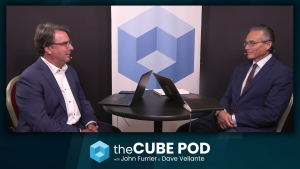Will the worlds of Hadoop and Big Data combine or collide? | #HPBigData2014
![]() Is there going to be a war on database formats, and will the worlds of Hadoop and Big Data combine or collide in the enterprise? These questions were raised just before Janath Manohararaj took the stage at SiliconANGLE’s roving news desk theCUBE, as the Team Lead of Database Services with Blue Cross and Blue Shield Assoc. spoke behind the scenes with theCUBE co-hosts John Furrier and Dave Vellante. These hot-button topics were intriguing enough to spill into Manohararaj’s segment, kicking off his live interview from the HP Vertica Conference.
Is there going to be a war on database formats, and will the worlds of Hadoop and Big Data combine or collide in the enterprise? These questions were raised just before Janath Manohararaj took the stage at SiliconANGLE’s roving news desk theCUBE, as the Team Lead of Database Services with Blue Cross and Blue Shield Assoc. spoke behind the scenes with theCUBE co-hosts John Furrier and Dave Vellante. These hot-button topics were intriguing enough to spill into Manohararaj’s segment, kicking off his live interview from the HP Vertica Conference.
Speaking on databases and delving into the Hadoop landscape, Manohararaj reminded viewers that in the beginning there were relational databases, and Big Data was so new it remained a distinct faction of the market. As far as Blue Cross Blue Shield was concerned, the health insurance provider never saw a risk of database collision with Big Data. Quite the contrary, it anticipated that things were all converging for the purposes of data management.
Vellante wanted to find out how this company has historically been using data. Manohararaj mentioned that the old way of dealing with data implied that each project would have its own data warehouse, with the cost of ownership being very high because data was replicated. In contrast, Hadoop makes things easier, bringing costs down and improving performance.
Recalling the “a-ha!” moment when his company realised the potential of Hadoop, Manohararaj admitted that initially Blue Cross Blue Shield had pre-database configuration, introducing Vertica into their system around 2008. Manohararaj’s team immediately noticed a performance boost, improving 10x faster than before.
“The first step was moving from traditional DBMS to columnar base. Now we are thinking about creating a data lake, one unified repository” admitted Manohararaj.
Balancing compliance with innovation
Regarding the healthcare sector, Furrier wanted to find out more about the way Blue Cross Blue Shield is balancing the demands of industry compliance with the need for innovation.
“With healthcare, explained Manohararaj, “the information needs to be instantaneous, which used to be a problem before. Vertica is one of the best databases that we work with.”
“Vertica is the Ferrari of the industry,” agreed Furrier, prodding Manohararaj to explain what makes Vertica so successful. Manohararaj listed three key factors:
- performance
- low costs
- really good support (proactive, vs calls and call backs)
Open source vs. vendor distribution
A final topic discussed during Manohararaj’s interview looked at the emerging processes commercializing Big Data for the enterprise, where a collision of another sort is happening.
“Are you using a vendor distribution or open source Apache Hadoop?” asked Vellante, curious about the enterprise implications underlying the two opposing methods of selling Big Data solutions. Manohararaj disclosed that it is a work in progress and that they are moving towards open source: “The open source has always been a challenge, there are always steep learning curves and you need training. With proprietary solutions, it’s much easier.”
A message from John Furrier, co-founder of SiliconANGLE:
Your vote of support is important to us and it helps us keep the content FREE.
One click below supports our mission to provide free, deep, and relevant content.
Join our community on YouTube
Join the community that includes more than 15,000 #CubeAlumni experts, including Amazon.com CEO Andy Jassy, Dell Technologies founder and CEO Michael Dell, Intel CEO Pat Gelsinger, and many more luminaries and experts.
THANK YOU









